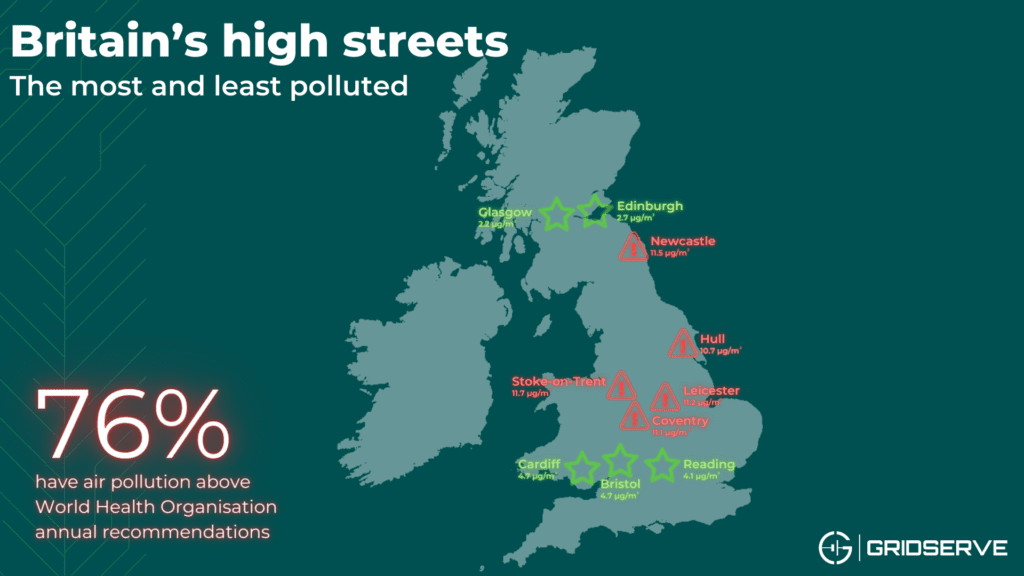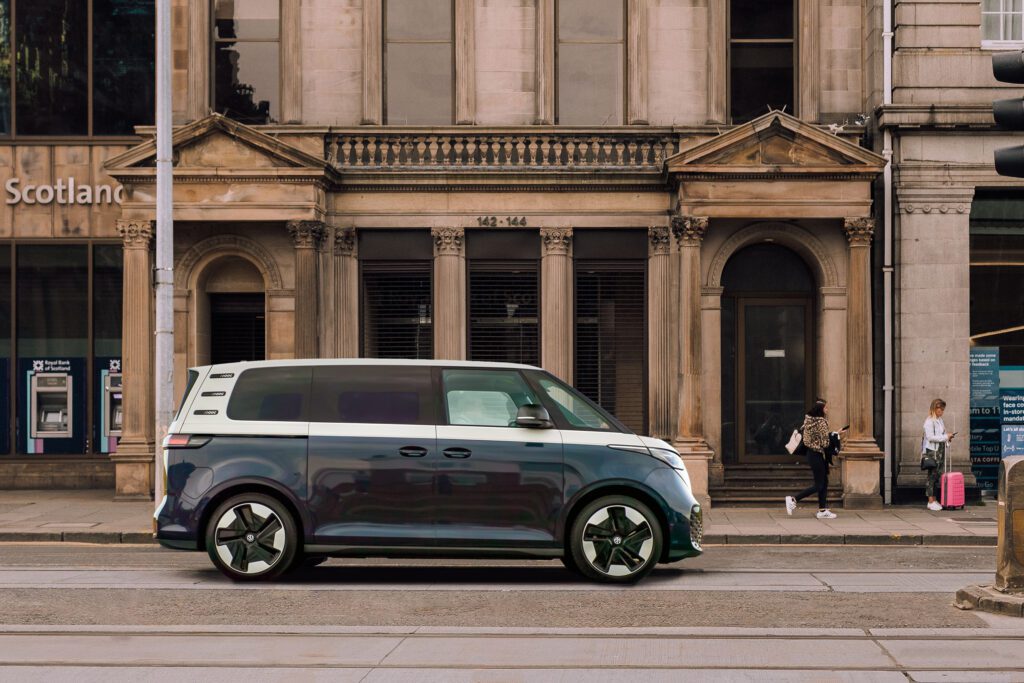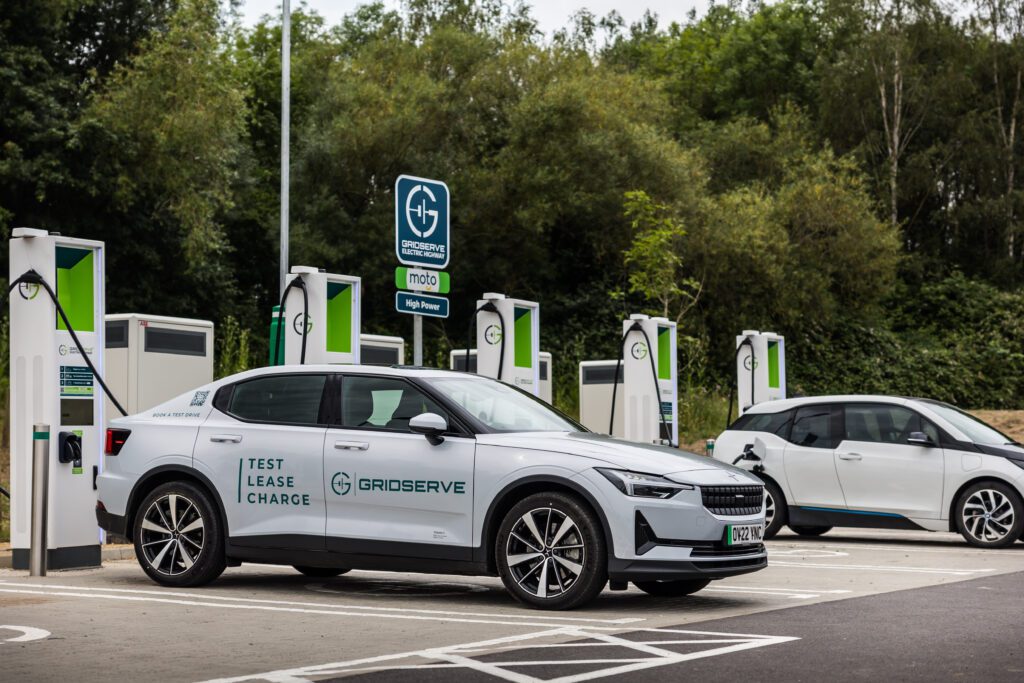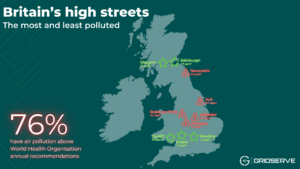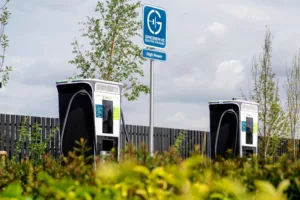Around three quarters (76%) of British high streets may exceed the World Health Organisation’s recommended annual level of air pollution.
That’s according to a new study from sustainable energy provider GRIDSERVE, which used an air quality measuring device[i] to conduct air pollution spot checks on the main high streets[ii] of the 25 largest towns and cities in Britain over a two-week period.
Specifically, researchers measured the level of PM2.5 pollutants in the air, meaning particulate matter that is less than 2.5 micrometres in diameter[iii]. Particulate matter (PM) is everything in the air that’s not gas and consists of many chemical compounds and materials. Because of their small size, they can enter the bloodstream and cause illnesses such as asthma, heart disease and lung cancer.
The World Health Organisation’s recommendation, acknowledged by the Government’s Committee on the Medical Effects of Air Pollutants[iv], is that annual levels of PM2.5 should not exceed 5 micrograms per cubic meter air (µg/m3).
Only six of the 25 high streets in the study recorded an average reading of 5 µg/m3 or lower. Stoke-on-Trent had the highest average level of PM2.5 in the air (11.7), followed by Newcastle (11.5) and Leicester (11.2). Newcastle also registered the highest single reading of 20.5.
Conversely, Glasgow was shown to have the cleanest air with a PM2.5 reading of just 2.2 µg/m3, followed by Edinburgh (2.7). Interestingly, Scotland was the first country in Europe to adopt the WHO recommended limit for PM2.5 in 2016[v].
While no pattern was found regarding whether the high streets were pedestrianised or not, high streets were found to have on average 53% more PM2.5 in the air than the closest park (park average 4.7 µg/m3 compared to high street average 7.2).
Additional research among 2,000 adults reveals 40% of adults are concerned about the air quality on the street where they do most of their shopping, with emissions from cars being the main reason (60%). Nearly half of people think more plants (46%) or fewer cars (44%) would improve air quality, while a third think more electric vehicles would help (36%).
As a result, more than a third of people (36%) have concerns over the health of the local community due to air pollution, or the health of their family or themselves (26%/25%). Around a quarter of people are trying to find greener ways to travel (26%), while just over one in 10 avoid shopping where there are lots of cars (12%) or just forgo the high street in favour of online shopping (11%). A similar number are going to do more of their Christmas shopping virtually this year to avoid high street pollution (10%).
Sam Clarke, Chief Vehicle Officer at GRIDSERVE, said: “With millions set to hit the high street this festive period, we wanted to look at the state of the nation’s air quality in the locations people will be doing most of their Christmas shopping. It’s shocking to see that so many were above the World Health Organisation’s annual recommendations for air pollution, and that one in 10 shoppers are even planning on foregoing the high streets altogether due to air quality.”
“If we’re to reach the World Health Organisation’s annual target of 5 µg/m3 of PM2.5 in our air, collectively we need to change our behaviours. With vehicle emissions being a key contributor, anything we can do to travel more greenly, from walking more to cycling, and including electric vehicles, is a very valuable set forward to improve the air we breathe daily.”
High street’s Air Quality ranked – cleanest to most polluted (average PM2.5 score).
- Glasgow (Buchanan Street) – 2.2
- Edinburgh (Princes Street) – 2.7
- Reading (Broad Street) – 4.1
- Cardiff (St Mary Street) – 4.7
- Bristol (Broadmead) – 4.7
- Plymouth (New George Street) – 5.0
- Portsmouth (Commercial Road) – 5.1
- Leeds (Briggate) – 5.3
- Brighton (Western Road) – 5.6
- Sheffield (Fargate) – 6.3
- London (Oxford Street) – 6.8
- Derby (St Peter’s Street) – 6.9
- Liverpool (Church Street) – 7.1
- Birmingham New Street – 7.3
- Northampton (Abington Street) – 7.3
- Manchester (Market Street) – 7.6
- Luton (George Street) – 7.6
- Nottingham (High Street) – 7.7
- Southampton (Above Bar Street) – 8.8
- Bradford (Broadway) – 10.6
- Hull (Jameston Street) – 10.7
- Coventry (West Orchards Way) – 11.1
- Leicester (Gallowtree Gate) – 11.2
- Newcastle (Northumberland Street) – 11.5
- Stoke-On-Trent (Parliament Street) – 11.7
About the research
There were two distinct research elements:
GRIDSERVE commissioned Pickersgill Consultancy and Planning Ltd’s (PCP) team of fieldworkers measured the air quality in high streets and parks across Great Britain’s top 25 most-populated towns and cities. An air quality monitoring device was used to measure the PM2.5 and PM10 in the air, which means where particulate matter (PM) are less than 2.5 micrometres in diameter and less than 10 micrometres in diameter respectively.
During the first week of the research, for each location, two readings of both PM2.5 and PM10 were taken, roughly 200 metres apart, on a main high street road and one reading of PM2.5 and PM10 was taken at a central, park location. Then in the second week of research, in addition to the same main high street readings, one reading of PM2.5 and PM10 was taken at an additional city centre road but with traffic present. All data was gathered at roughly 11am on either a Tuesday, Wednesday, or Thursday to ensure as much comparability as possible between the locations.
Additional omnibus research conducted by One Poll in October 2023, sample was 2,000 UK adults.
References
[i] Device used was the Temtop M2000C CO2 Air Quality Monitor, which detects CO2, PM2.5, PM10
[ii] High street was defined as the primary shopping location of the area and the place with the highest proportion of iconic ‘high street shops’.
[iv] Source https://www.gov.uk/government/publications/fine-particulate-air-pollution-pm25-setting-targets#full-publication-update-history. More can be read on the WHO site here: https://iris.who.int/bitstream/handle/10665/345329/9789240034228-eng.pdf?sequence=1

About GRIDSERVE
